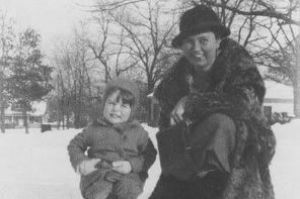Concert
Ensemble Modern III
Portrait Ruth Crawford Seeger: Solos / Duos / Ensemble

Here as a duo: Ruth Crawford Seeger with her son Mike in the snow, ca. 1935 © peggyseeger.com
A matinée of chamber music – but in this case a special event: in a strictly choreographed concert design, the Ensemble Modern traces the numerous experimental forms that composer Ruth Crawford Seeger employed in her brief career in the interwar years, from dissonant counterpoint to serial techniques. The third part of this portrait series presents the US composer’s chamber works.
The youthful Ruth Crawford studied piano and composition at the American Conservatory of Music in Chicago, as a result of which no lesser figure than the composer Henry Cowell arranged for his former teacher Charles Seeger to accept her as a pupil in 1929. That same year the would-be composer became the first woman to receive a Guggenheim Fellowship to spend a year in Europe, where she met established greats such as Alban Berg, Béla Bartók, Josef Matthias Hauer, Arthur Honegger, Albert Roussel and Nadia Boulanger. After she returned to the USA, Ruth Crawford married Charles Seeger, with whom she transcribed thousands of recordings in the Library of Congress’s archive of folk songs. While her early works had been influenced by neo-Romanticism and impressionism, after she began studying with Seeger, she adopted his composing methods using the rules of “dissonant counterpoint.” These turn the traditional rules of counterpoint upside down, with consonances being continued as dissonances and the concept of dissonance being applied to changes of metre and time. From this period onward, Crawford Seeger also worked with serial techniques, tone clusters, spoken voices, rhythms that were independent from voices, sounds groups that were spatially separated from each other and various other experimental practices. On the third and final day of concerts devoted to Ruth Crawford Seeger’s overall ouevre, the Ensemble Modern presents the broad spectrum of the composer’s chamber music works, to be played in sequence by a variety of different chamber ensembles spread around the hall.
Programme
Ruth Crawford Seeger (1901 – 1953)
String Quartet (1931)
Sonata (1926)
for violin and piano
Little Waltz (1922)
for piano
Little Lullaby (1923)
for piano
Jumping the Rope (Playtime) (1923)
for piano
Whirligig (1923)
for piano
We Dance Together (1926)
for piano
Mr. Crow and Miss Wreng go for a walk - a little study in short trills (1923)
for piano
Caprice (1923)
for piano
Piano Sonata (1923)
Diaphonic Suite No. 1 (1930)
for oboe or flute solo
Diaphonic Suite No. 2 (1930)
for bassoon and violoncello
Kaleidoscopic Changes on an Original Theme Ending with a Fugue (1924)
Suite (1952)
for wind quintet
Five canons (1924)
for piano
Diaphonic Suite No. 3 (1930)
for two clarinets
Theme and Variations (1923)
for piano
Diaphonic Suite No. 4 (1930)
for oboe and violoncello
Piano Study in Mixed Accents (1930)
9 Preludes (1924 – 28)
for piano
Contributors
An event by Berliner Festspiele / Musikfest Berlin
Supported by the Capital Cultural Fund
Ensemble Modern would like to thank the Library of Congress in Washington for its kind support in researching Ruth Crawford Seeger’s music.
With the kind support of the Ensemble Modern Patronatsgesellschaft e.V.